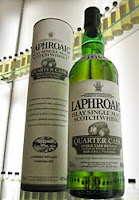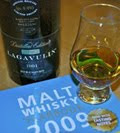
Penderyn (pronounced
Pen-derrin) is the only single malt whisky distillery currently operating in Wales. It is located in the village of Penderyn in the Brecon Beacons National Park in south Wales. The distillery is one of the youngest in the UK and is owned by the Welsh Whisky Company, which is made up of a consortium of local businessmen. The WWC was formed in 1998 and production began at Penderyn in September 2000. They adopted the name of the village - it translates as '
head of the kite' from the Welsh language (that's
kite as in the type of bird and the Brecons is home to one of the largest populations of them in the UK).

Penderyn is the first legal distillery to produce single malt whisky in Wales for over 100 years. The previous one was named Frongoch (pronounced
fran-gok) and this was located in the town of Bala in north Wales, close to the famous Snowdonia National Park. The distillery had a short life - the first spirit flowed in 1889 and it was closed in 1900, with the company being wound up in the High Court in 1903. They rather cheekily named their whisky 'Royal Welsh Whisky' (
as shown on one of their posters, left), despite never being issued a Royal Warrant. Prince Charles, the current Prince of Wales, is one of the Penderyn's biggest supporters and serves Penderyn whisky at his Highgrove House residence.
Our tour of Penderyn is taken by Sian Whitelock, the Commercial Director at the Welsh Whisky Company. It begins in the impressive visitor centre (actually, it began at Aberdare train station where Sian met us!). The visitor centre and the distillery are all housed under the same roof. The building looks impressive from the outside - it is black and has the increasingly recognisable Penderyn gold flash adorning it (
see top image, above). We learn that this flash represents a seam of rare Welsh gold that can still be found in the local area and that the words
Aur Cymru and
AC initials that are on Penderyn labels, means 'Welsh gold' in Welsh.

The tour begins with an exhibition about Penderyn and its place within the local, Welsh and whisky communities. It feels fresh and light and gives plenty of information on wall and free standing boards and also a short film. The exhibition explains how the geology of the local area and the quality of their water source helped pick the distillery's location (it has a bore hole located next it). There is also a collection of interesting artifacts relating to the old Frongoch distillery, including one of the few bottles left in existence. However, our favourite part was a historical time line that stretched along one side of the room that incorporated significant dates in Welsh, world and whisky history. This helps greatly in putting Penderyn in to context within these three categories.
Next, Sian takes us through to the still room viewing area. Here, we get to see the unique set up that Penderyn have. Firstly, the production process is different. They use a pre-made fermented wash that is made to Penderyn's specifications at the Cardiff based Brain's brewery. In the Scottish whisky industry, the mashing and fermentation processes must happen on the same site as the distillation. We had a sniff of this pre-made wash and it was like a sweet ale, without the hops.
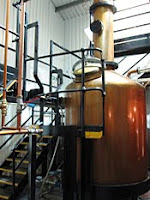
The still room is viewed through glass on the regular tour, but we were fortunate enough to be taken in to have a more detailed look through the tiny still room. This unique copper still was specially designed by Dr David Faraday, who is descended from Sir Michael Faraday (a pioneering scientist who studied electricity and magnetism and invented such things as the electric motor and the dynamo). The still has three main sections that are linked. A copper pot still (
seen in the image, left) has a pipe leading from the top to another column-still-like structure and the final spirit is collected in a huge glass bulb still safe. The production is a batch process, with each batch taking roughly 10 hours and producing just a single cask of spirit.
The still produces very little waste product as for each charge or batch, it runs on a continuous process. The fermented Brain's wash is heated and the evaporated alcohol vapour rises up the neck before passing along the pipe to go through the column-still-like section. Here, the vapours
begin to re-condense and in a similar way to a column still the vapours can be collected as the desired spirit given that they re-condense at the desired point at which they are removed then piped in the huge glass bulb still safe. The spirits that are not collected are returned to the original copper pot part of the still via another pipe. They then pass through the process again and again until just 1% of the original 2500 litres put into the still is remaining. It is a fascinating set up and one that is truly unique, from transporting the wash in to the still design but also that this entire operation is manual.
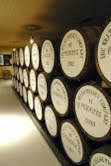
The spirit that is collected is higher in alcoholic strength (known as the ABV) than the Scottish distilleries casking strength. Penderyn's new make spirit is roughly 80% ABV when it is put into the cask, whereas the average figure is around 65% in Scotland. A higher ABV will mean that the spirit will draw more from the wood in the cask and therefore mature at a quicker rate. We tried some of the new make spirit and despite its strength, it was extremely fresh, vibrant and fruity (think of green juicy fruits like pears and apples) with a spicy chili-like nature to it. The casks are not stored on the compact site of the distillery/visitor centre but in a warehouse a few miles away.
Penderyn use ex-bourbon casks for the majority of their whisky's maturation. These are sourced from the Buffalo Trace distillery in Kentucky, USA. The core range of Penderyn consists of three single malts - the regular release is then part matured in Madeira casks and there are two further, more limited bottlings. The
Sherrywood is part matured in sherry casks
and the
Peated is part matured in ex-Islay smoky whisky casks (this is where it gets its peatiness, rather than using peated malt in the more traditional way).
The whiskies are closely monitored and selected at their optimum age by Master Distiller Dr Jim Swan and on-site distiller Gillian MacDonald.

Penderyn is also one of the few distilleries that do their own bottling. This is again viewed through a large glass window but we were allowed in to observe from a safe area. They bottle all of their products, including the
Brecon gin and
Five vodka that they also produce at the distillery. Before bottling, the whisky is brought down to 46% ABV using water from the local bore hole. The tour then concludes with a tasting in the sampling area (we were the first people to try out their new stylish chairs here!). On the regular tour, you are treated to two drams but we got the 'special' treatment! Sian and ourselves were joined by distiller Gillian MacDonald and Visitor Centre Manager Keith Tench, who sampled and explained everything from their current range.
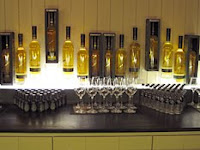 Tasting notes
Tasting notes
Penderyn Madeira - this is the cornerstone of the Penderyn range. The colour is straw-like with an interesting fragrant nose - vanilla, fresh fruits (apples/pears) and something herbal (dried grasses). On the palate, this remains light with sugary caramel, dried fruits and malted cereal notes present. The vanilla, fresh fruit and herbal elements from the nose come through also. The finish is reasonably long for something a light whisky and is refreshing, with an enjoyable sugary sweetness and woodiness. For our full review -
click here.
Penderyn Sherrywood - partly matured in sherry casks, this whisky is golden amber in colour. The nose has an interesting combination of aromas - dried fruit (sultanas/orange peel), caramel, spices (cloves) and herbal grassy note (imagine dried grasses/hay). On the palate, there is sugary sweetness (brown sugar/honey), then dried fruit (sultanas/dried apple). It is buttery and coats the inside of your mouth. The finish is again initially sweet before a grassiness kicks in and makes the finish pleasantly dry.
Click here for our full review.
Penderyn Peated - this is partly matured in ex-smoky whisky casks. Therefore, the peatiness is subtle. The colour is light and straw-like and the nose is subtle and fresh (vanilla/toffee/damp earth). On the palate, there is fresh fruit (pears/apples), vanilla and something floral (maybe honeysuckle) before the earthy peat smoke comes through. The finish becomes grassy, herbal and a little dry. Our full review will follow shortly.
Penderyn Rich Madeira - a limited edition whisky that was bottled to commemorate the 125th anniversary of the Welsh Rugby Union Association. It has been matured in ex-bourbon casks then one year in a Madeira cask. Released at 50% ABV, there are only 1250 bottles. It is rich amber in colour and the nose is sweet (caramel) and fruity (dried fruits/sultanas/candied orange peel). These aromas carry through to the palate, combining very well with wood spice (cinnamon/nutmeg) and herbal (dried grasses) notes. A lovely long sweet finish. Our favourite whisky of the day. Our full review will follow shortly.
Penderyn Port Wood - this is Penderyn's most expensive (£275) and smallest (207 bottles) release to date. It was released in August 2009 and bottled at 60.6% ABV. The colour is dark amber/red and the nose has individuality - plenty of caramel/treacle, candied orange peel, dried red fruits and cocoa powder. This is rich on the palate but easy drinking, despite the strength. It is silky with the notes of the nose replicated. With water, more caramel/toffee comes out. The finish is rich, fruity and dry. This reminded us of an Armagnac or Cognac. Our full review will follow shortly.
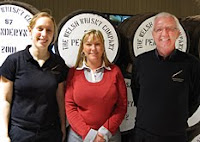
The tour of Penderyn is unlike any other that we have been on, but that is because Penderyn is unlike any other distillery that we have been to. If you go expecting to see the grain mill, mashing, fermenting and maturation as on a traditional distillery tour then you may leave disappointed. However, this offers something fresh and new with a modern, ground breaking take on the traditional techniques. We both thoroughly enjoyed our time and recommend it highly. We thank Gillian MacDonald, Sian Whitelow and Keith Tench at Penderyn (
pictured from left to right, respectively), for the invite to their distillery, their hospitality and information while we were there and for letting us sample their innovative whiskies.
Information for the regular Penderyn tourEntry - £5 per person/ Tour duration - 45 mins/ No. of drams - 2/ Further details -
www.welsh-whisky.co.uk
 A Taiwanese whisky?
A Taiwanese whisky?
















